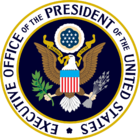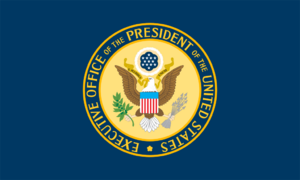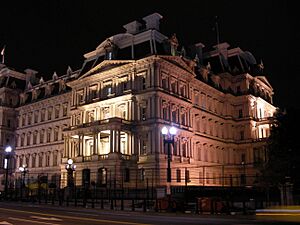Executive Office of the President of the United States facts for kids

Seal of the Executive Office
|
|

Flag of the Executive Office
|
|
| Agency overview | |
|---|---|
| Formed | July 1, 1939 |
| Jurisdiction | U.S. Federal Government |
| Headquarters | White House, Washington, D.C., U.S. |
| Employees | 1,800 (approximately) |
| Annual budget | $714 million |
| Agency executive | |
The Executive Office of the President of the United States (EOP) is a group of offices and agencies. They help the President do their job. Think of it as the President's main support team.
This office includes many important parts. Some examples are the White House Office (which has the staff working closest with the President), the National Security Council, and the Office of Management and Budget. Most of these staff members work in the Eisenhower Executive Office Building.
The EOP is sometimes called a "permanent government." This is because many of its programs and the people who run them continue even when a new President takes office. The people who work here are usually seen as neutral. This means they give advice that is fair and not based on politics.
Over time, the number of staff in the White House has grown. This is because the world has become more complex. As of 2015, about 1,800 people worked in the EOP. Most of these jobs do not need approval from the U.S. Senate.
The EOP is led by the White House chief of staff. Since January 20, 2025, Susie Wiles has held this important role. She was chosen by President Donald Trump. She is also the first woman to be the White House Chief of Staff.
History of the EOP

The idea for the EOP started in 1937. A group of experts called the Brownlow Committee suggested big changes. They wanted to make the executive branch of the government work better.
Based on their ideas, President Franklin D. Roosevelt asked Congress to approve a new law in 1939. This law, called the Reorganization Act of 1939, created the EOP. It was designed to report directly to the President.
When it first started, the EOP had two main parts. These were the White House Office and the Bureau of the Budget. The Bureau of the Budget is now known as the Office of Management and Budget. At first, the EOP staff was small. But it set the stage for the much larger White House staff we see today.
Before Roosevelt, Presidents had very few helpers. For example, Thomas Jefferson only had one messenger and one secretary. Congress didn't even pay for a clerk until 1857. By 1900, the White House staff had grown a bit. It included a "secretary to the president" and a few other people.
During Herbert Hoover's time, more secretaries were added. One of them became the first press secretary. President Roosevelt relied on his "brain trust" of smart advisors. They helped him manage the government's response to the Great Depression.
After World War II, the EOP grew even more. President Dwight David Eisenhower, who was a general, reorganized the office. He made it fit his leadership style.
Today, the EOP has many more staff members. Estimates show that between 3,000 and 4,000 people work there. This large staff helps the President manage many different policy areas. Sometimes, it can be a challenge for the President to coordinate all the different departments.
How the EOP is Organized
The President has the power to change how the EOP is set up. This power comes from the 1949 Reorganization Act. The White House chief of staff is the main leader of the EOP. They help decide what issues the President needs to handle personally. They also decide what can be managed by other staff members.
People who work in the EOP have special titles. The most senior staff are called Assistant to the President. The next level down are Deputy Assistant to the President. The third level are Special Assistant to the President.
Most EOP staff do not need approval from the U.S. Senate. However, a few important roles do. These include the director of the Office of Management and Budget and the United States Trade Representative.
Here are some of the main parts of the EOP and who leads them as of January 20, 2025:
| Agency | Principal executive | Incumbent |
|---|---|---|
| White House Office | Assistant to the President and Chief of Staff | Susie Wiles |
| National Security Council | Assistant to the President for National Security Affairs | Marco Rubio |
| Homeland Security Council | Assistant to the President for Homeland Security | Stephen Miller |
| Council of Economic Advisers | Chairman of the White House Council of Economic Advisers | Stephen Miran |
| Council on Environmental Quality | Chairman of the Council on Environmental Quality | Vacant, TBD |
| Executive Residence Staff and Operations | White House Chief Usher | Robert B. Downing |
| National Space Council | Executive Secretary of the National Space Council | Chirag Parikh |
| President's Intelligence Advisory Board | Chairman of the President's Intelligence Advisory Board | Devin Nunes |
| Office of Administration | Director of the Office of Administration | Dave Noble |
| Office of Management and Budget | Director of the Office of Management and Budget | Russell Vought |
| Office of National Drug Control Policy | Director of National Drug Control Policy | Vacant, TBD |
| Office of the National Cyber Director | National Cyber Director | Vacant |
| Office of Science and Technology Policy | Director of the Office of Science and Technology Policy | Michael Kratsios |
| Office of the United States Trade Representative | United States Trade Representative | Jamieson Greer |
| Office of the Vice President of the United States | Assistant to the President and Chief of Staff to the Vice President | Jacob Reses |
White House Offices
The White House Office is a big part of the EOP. It includes many smaller offices that help the President every day.
- Office of the Chief of Staff
- Office of the National Security Advisor
- Domestic Policy Council
- National Economic Council
- Office of Cabinet Affairs
- Office of Digital Strategy
- White House Office of Communications
- Office of the First Lady
- Office of Intergovernmental Affairs
- Office of Legislative Affairs
- Office of Management and Administration
- Office of Political Affairs
- Office of Public Engagement
- Office of Presidential Personnel
- Office of Scheduling and Advance
- Office of the Staff Secretary
- Office of White House Counsel
- Oval Office Operations
- White House Fellows
- White House Military Office
- Department of Government Efficiency
EOP and Congress
The Congress also has a say in how the EOP works. Congress controls the money that the EOP and other government agencies receive. This is called the "power of the purse."
Congress can also investigate the EOP. They often hold hearings where EOP staff members answer questions. The EOP also helps Congress write new laws. They provide expert details for laws that might start out as broad ideas.
See also
 In Spanish: Oficina Ejecutiva del Presidente de los Estados Unidos para niños
In Spanish: Oficina Ejecutiva del Presidente de los Estados Unidos para niños

